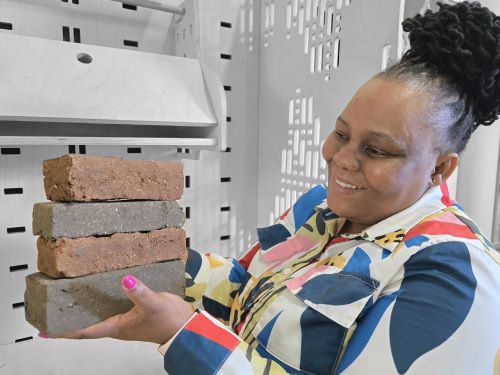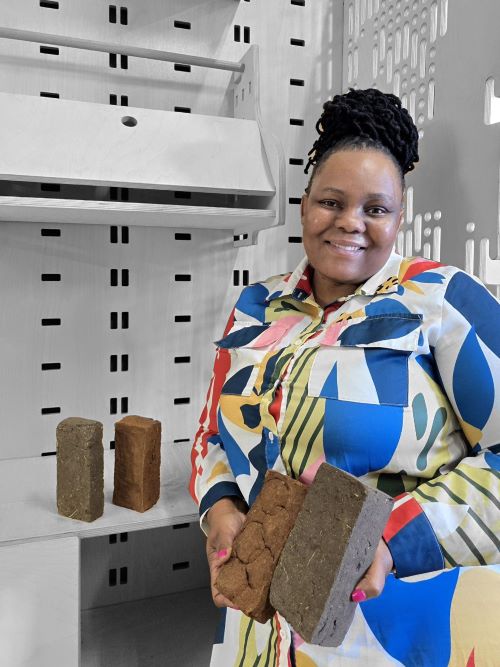by Gerrit Bester
Nokulunga Kraai, a part-time lecturer at the Department of Interior Design, Faculty of Arts and Design, has been awarded R5 000 by the Rail Manufacturing Centre of Entrepreneurship & Rapid Incubator (RMCERI), a business incubator dedicated to supporting tech-driven SMMEs. The funding recognises her innovative cow dung mix eco-brick prototype. In an interview, Kraai discussed her design approach and the inspiration behind her eco-friendly innovation.
What inspired you to develop eco-brick prototypes using cow dung mix? The inspiration behind developing the eco-brick prototype stemmed from the urgent need for affordable and sustainable housing solutions in disadvantaged communities, particularly in rural and peri-urban areas. These communities are often faced with severe housing shortages, with limited access to conventional building materials due to high costs and supply constraints.
My aim was to explore locally sourced, low-cost materials to reimagine modern construction needs. Cow dung has long been used in traditional African building methods. The choice of material was intentional, not only is it familiar and culturally accepted within the communities, but it also holds potential for small-scale manufacturing.
This could empower community members to participate in the production process, ultimately creating job opportunities, building local skills and fostering a sense of ownership in the development of their built environment.
How did your studies in Interior Design influence your approach to sustainable building materials? My studies in Interior Design played a significant role in shaping my approach to sustainable building materials. It taught me to think holistically about space, not just how it looks, but how it functions, how it feels and how it impacts both people and the environment. I became increasingly aware of the environmental footprint of construction and the importance of material choices in creating healthy, sustainable interiors.
What are the unique features of your eco-bricks that make them environmentally beneficial? The eco-bricks are designed with an interlocking shape, which requires minimal mortar during construction and are made from natural, locally accessible materials. Their low-energy, low-cost production method aims to help reduce construction waste and environmental impact.
Could you walk us through the process of creating your prototypes and the challenges you faced along the way? I began by developing four prototype bricks, each with varying densities. The goal was to explore how different ratios of cow dung, soil and binding materials would affect the strength, texture and overall performance of the bricks. I used a trial-and-error method, starting with smaller sample bricks to test how the mixture would behave before moving on to full-size bricks.
Initially, mixing the ingredients by hand for the smaller samples was manageable. However, as I scaled up to life-size bricks, I encountered significant challenges. The mixing process became extremely labour-intensive and achieving a consistent blend proved difficult without proper equipment. This made me realise that for large-scale production, investing in an industrial mixing machine would be essential to ensure uniformity and efficiency.
Designing the brick itself also came with its own set of complications. I wanted to move away from the traditional rectangular brick shape and instead create a more innovative interlocking design. The idea was to reduce the amount of mortar needed and allow for the construction of cavity walls, improving insulation and lowering costs.
While the concept looked promising on paper, the interlocking sections were fragile and often broke during demoulding or drying. Additionally, the complex shape made it difficult to remove the bricks from their moulds without damage.
Initially, I used wooden moulds, but the moisture content in the mixture caused the wood to expand, making the moulds warp and stick. I then tried foam board, which worked slightly better, but wasn't durable enough for repeated use. This led me to conclude that steel moulds would be the most suitable for the demands of consistent, long-term production.
Overall, creating the cow dung brick prototypes taught me a lot about material behaviour, production challenges and the importance of designing with both functionality and scalability in mind.
While there were setbacks, each challenge offered valuable insights that will guide the next phase of development as I work toward refining the brick's shape, strength and production process.
How did it feel to win the R5 000 award and to have your work recognised in this way? Winning the R5 000 award and having my work recognised in this way is an incredibly humbling and affirming experience. It felt like a moment of validation.
This reinforced that there is real value in exploring unconventional solutions to challenges in our built environment. More than the financial reward, the recognition gave me a renewed sense of purpose and motivation to keep pushing forward, to refine the design and to continue contributing to sustainable, locally-driven solutions in design. It made all the late nights, failed prototypes and physical labour feel completely worth it.
What impact do you hope your eco-bricks will have on communities or the construction industry? I hope that my eco-bricks have a transformative impact on both communities and the design industry in meaningful ways. I envision these bricks becoming a steppingstone toward more affordable, accessible and sustainable housing and hope the production process will open new opportunities for local employment and skills development, empowering residents to become active participants in the building of their own homes and neighbourhoods.
Ultimately, the end goal is for the eco-bricks to spark a broader conversation around rethinking waste, embracing Indigenous Knowledge Systems and designing with both people and the planet in mind.
How did the collaboration with RMCERI and the mentorship support you in developing and refining your prototypes? The collaboration with RMCERI and the mentorship received will play a pivotal role in shaping the development and refinement of my cow dung brick prototypes.
RMCERI provides a structured and supportive environment which I will engage deeply with my ideas to receive critical feedback grounded in research and practical insight. Their mentorship will help me move beyond conceptual thinking and focus on technical accuracy, scalability and community relevance.
Overall, the partnership with RMCERI will give me the tools, confidence and critical lens needed to turn an idea into a tangible prototype with real potential to make a difference.
What advice would you give to other students or alumni interested in pursuing sustainable design solutions? My advice to other students or alumni interested in pursuing sustainable design solutions is this: Start where you are, use what you have and don’t be afraid to question the norm.
Sustainability isn’t just about using eco-friendly materials, it’s about rethinking systems, being resourceful and finding value in places others might overlook.
Be curious and bold in your research. Look to nature, traditional knowledge systems and your own community for inspiration.
Often, the most effective solutions are rooted in simplicity and local relevance. Don’t underestimate the potential of natural or “waste” materials, they can lead to powerful innovations when approached creatively and with intention.
What are your next steps in developing or implementing your eco-brick prototypes? My next steps in developing and implementing the eco-brick prototypes involve a combination of refinement, testing and strategic collaboration to move the project closer to real-world application.
Are there other sustainable or innovative design projects you're working on or plan to explore? Yes, the success and learning from the eco-brick project have inspired me to continue exploring other sustainable and innovative design solutions.
One project I’m currently conceptualising involves affordable, natural floor finishes using a combination of clay, cow dung and other earthen materials.
The idea is to design a flooring solution that is cost-effective, durable and thermally efficient, while also drawing from indigenous construction knowledge that has been used for generations.
My passion lies in designing with purpose, creating solutions that are rooted in context, inspired by nature and capable of empowering communities.
Every project I pursue is driven by the belief that sustainability should be inclusive, culturally relevant and accessible to all, not just a privilege for a few.
* This achievement builds on a recent collaboration involving an incubation project with senior students, where alumni also showcased their prototypes.

Nokulunga Kraai, a part-time lecturer at the Department of Interior Design, with her cow dung mix eco-brick prototype.

READ MORE ABOUT RMCERI AT: https://rmceri.org
